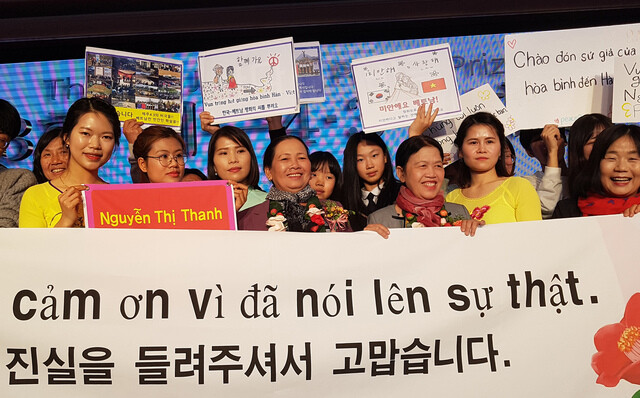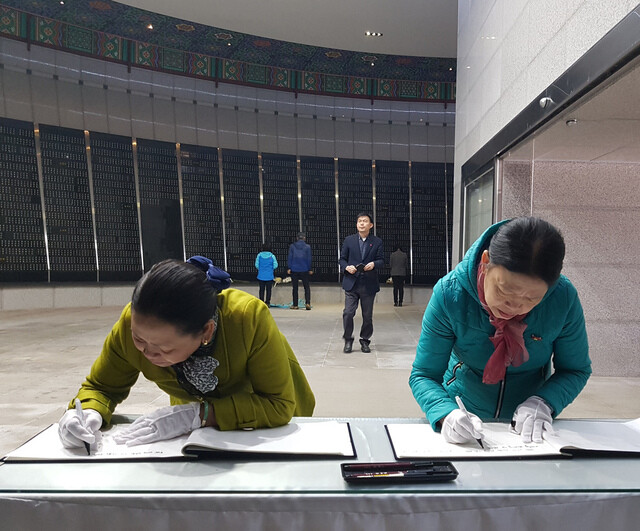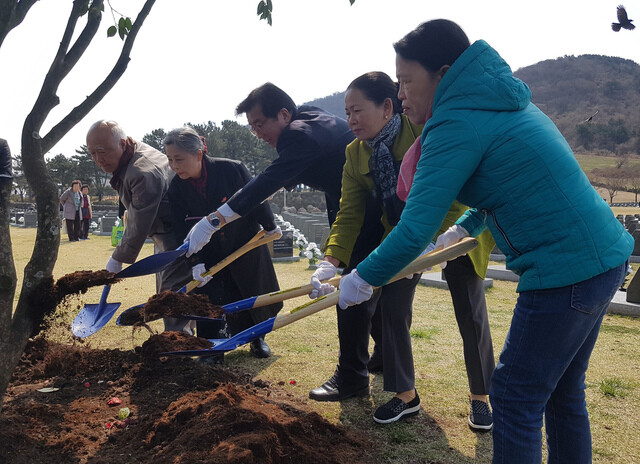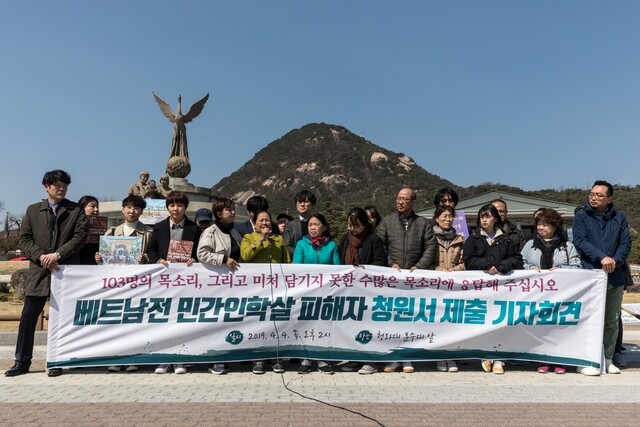hankyoreh
Links to other country sites 다른 나라 사이트 링크
[Reportage] 5-day journey of 2 victims of civilian massacres by South Korean troops during Vietnam War

Vietnam has had countless tragedies comparable to those that occurred on Jeju Island in 1948 and in Gwangju, a city in southwestern Korea, in 1980. Some of those tragedies occurred in the villages of Phong Nhi, Phong Nhat and Ha My in Quang Nam Province, where South Korean troops deployed to Vietnam brutally massacred civilians over the course of 10 days in February 1968. Nguyen Thi Thanh, 58, who was seven years old when Korean soldiers killed her family and shot her on the left side in Phong Nhi and Phong Nhat, shared her story with the Hankyoreh 21.
“The Jeju Massacre and the Gwangju Democratization Movement are no different from Vietnam in the sense that they were tragic massacres of civilians. The fields and villages of Jeju were like our own villages, as were the people who were laid low there. They were all women, children, and old people,” Nguyen said.
Another woman named Nguyen Thi Thanh, 61, from Ha My village, testified to the massacre during a “citizens’ peace tribunal” last year with the aim of casting light on civilian massacres by the Korean army during the Vietnam War. On Mar. 31, the two Nguyens arrived in South Korea to speak for themselves and other survivors. While in Korea, the two women met many others who have suffered similar things on Jeju Island and in Gwangju. They spoke of the massacres they had witnessed, which they had suffered in their own bodies.
The two Nguyens headed for the Blue House, carrying a petition signed by 103 victims of the civilian massacres who reside in 17 villages in Quang Nam and Quang Ngai provinces. The Hankyoreh 21 accompanied the two Nguyens on a five-day journey, from Mar. 31 to Apr. 4, which began in Jeju, passed through Gwangju and ended in Seoul. The conversations that the two Nguyens had with numerous women like them in Jeju and Gwangju were prepared as an article. Interpretation was provided by Ku Su-jeong, permanent board member for the Korea-Vietnam Peace Foundation, and by Nguyen Ha Phuong, a professor in the foreign language department of the Korea-Vietnam Friendship IT College.

Mar. 31: Wearing a badge of the red camellia flower
The two Nguyens entered the arrivals section of Jeju International Airport at 11:50 am. This was the third visit to South Korea by the Nguyen from Phong Nhi (Phong Nhi Nguyen), and the second by the Nguyen from Ha My (Ha My Nguyen). Phong Nhi Nguyen paid her first visit to South Korea as a war victim around the time of an exhibition of photography by Lee Jae-gap called “One War, Two Memories,” in 2015, on the 70th anniversary of Korea’s liberation from Japan’s colonial rule. On that trip, she’d been accompanied by a victim named Nguyen Tan Lan, from An Binh in Tay Vinh (formerly Binh An), a village in Binh Dinh Province. On subsequent trips, Phong Nhị Nguyen was a plaintiff with Ha My Nguyen in the citizens’ tribunal held in Seoul in 2018 and a recipient of the 3rd Special Jeju April 3 Peace Prize, which was awarded by the Jeju April 3 Peace Foundation, this year.
The two Nguyens won their case at the citizens’ tribunal in which they appeared as plaintiffs last year. Since it was a private tribunal set up by civic groups, it has no legal binding. Even so, victims from the villages of Phong Nhị, Phong Nhat, and Ha My flew to South Korea to testify of what they’d suffered. The tribunal judges, including former Supreme Court Justice Kim Young-ran, described the massacres as a “grave violation of human rights” and “incidents that could be characterized as war crimes.”
“The government needs to take an official position based on an acknowledgment of the facts, a measure that is essential for restoring the reputations and dignity of the victims,” the tribunal said, accepting the majority of the bereaved families’ requests.
Phong Nhi Nguyen has been waiting ever since. “My case wasn’t tried in an actual courtroom. Even so, my triumph in the citizens’ tribunal got my hopes up,” she said. But there was no discussion of an investigation or legal responsibility. “I was disappointed, but I felt I should keep waiting,” she recalled.
For Phong Nhi Nguyen, the news that she’d been awarded the Special Jeju April 3 Peace Prize was “good news” that caught her by surprise. At the same time, she said, she’d probably have been much happier to receive news that the South Korean government was acting on the recommendations of the citizens’ tribunal.
“That’s why I put the name ‘Nguyen Thi Thanh’ on the petition,” said Ha My Nguyen. “Don’t you think that all of us victims need to step up to deal with this issue?” Phong Nhi Nguyen said as she attempted to win over the villagers. The people of Ha My village had a request for Ha My Nguyen: “Since we’re not able to go ourselves, please deliver the petition on our behalf. We want you to represent us, since you testified to the tragedy our village suffered at the citizens’ tribunal in Korea.”
The two Nguyens departed from Da Nang International Airport in Vietnam around 1 am on Mar. 31. After touching down at Incheon, they transferred to Gimpo, where they caught a flight to Jeju Island. The faces of the two Nguyens had been lined with tension and fatigue from their 12-hour flight, but they soon lit up. Five people had come to the arrivals section to meet them, members of Jeju Peace Butterfly, a network of teenagers, university students, and young people working toward the resolution of the comfort women issue. The five members were carrying a placard with a message, written in Vietnamese, that said, “We’re going to stand with you.” These students had met the two Nguyens this past January. Phong Nhi Nguyen caressed the faces of the students, calling them “kids.” For the two Nguyens, it was a joyous reunion with their Korean friends, whom they’d said goodbye to three months earlier, hoping to meet again.
Around 6 pm, a welcome dinner was held prior to the awards ceremony for the Jeju April 3 Peace Prize, scheduled for the next day. During the dinner, Kang Woo-il, a bishop and the chair of the Jeju April 3 Peace Prize Committee, explained why the prize was being given to Phong Nhi Nguyen. “Several countries in Asia have criticized Japan for the lukewarm way in which it has reckoned with the issues of the past. That’s because the leaders of the Japanese government don’t have a factual recollection of the violent and heinous deeds that Japan committed throughout Asia and because they haven’t made a sincere apology for those deeds. If we don’t acknowledge or apologize for the civilian massacres perpetrated in the past by Korean troops in Vietnam, we’ll be unable to avoid the same criticism,” Kang said.
The recipient of this year’s peace prize was the novelist Hyun Ki-young, 78. Hyun released his novel “Uncle Suni,” which deals with the massacre of Bukchon Village, on Jeju Island, following a 30-year period when the residents of Jeju were compelled to remain silent about the massacre. After hearing about Hyun’s life, Phong Nhi Nguyen’s first instinct was to ask about his health. In 1979, Hyun was apprehended by the Defense Security Command and tortured because he’d written a novel about the Jeju Massacre. The woman had long been tormented by the memory of trying to keep her guts from spilling out of her belly as she roamed around trying to find her mother. During the dinner, the two Nguyens wore ceramic badges on their chest marking the 70th anniversary of the Jeju Massacare. The badges were in the shape of camellia flowers, just as the souls lost in the Jeju Massacare faded silently into the cold ground, like the red petals of the camellia.

Apr. 1: The ao dai dress worn at the awards ceremony
On Apr. 1, the next day, the two Nguyens visited the office of a notary public with Lim Jae-seong, an attorney with Haemaru Law Firm. Phong Nhi Nguyen was there to notarize documents that would be needed to sue the South Korean government for compensation later this year. “It’s meaningful to hold the government accountable when it’s denying and avoiding this issue. Even if the compensation lawsuit is successful, its remedy will be limited to the individual rights of the person filing the lawsuit. There are 9,000 victims of the civilian massacres by Korean troops. Prevailing in the lawsuit will also be highly symbolic by making the state acknowledge its responsibility,” Lim said.
It isn’t easy to find concrete evidence or witnesses, which is typical of government crimes, in which state organs long persist in denying the truth and make a concerted effort to destroy evidence. In most cases, the testimony of these elderly victims is the only testimony to be had. The massacres at Phong Nhị and Phong Nhat are unusual in the respect that there’s relatively more evidence available for them, including photographs taken by J. Vaughn, a corporal with the US Marines.
“At Ha My village, we don’t have the kind of concrete evidence that they do at Phong Nhi and Phong Nhat villages,” said Ha My Nguyen, who isn’t able to file a lawsuit for now. But she went ahead and notarized her documents, to prepare for the compensation lawsuit that she hopes to file eventually against the South Korean government. Ha My Nguyen said this makes her feel “sad.” Ten more people recently identified themselves as victims at Ha My, bringing the total to 145. Even so, Ha My Nguyen said she wasn’t able to do anything other than take care of the notarization.
That afternoon, the two Nguyens changed into ao dai, the traditional dress of Vietnam. They’d brought the outfits so they could wear formal attire to the awards ceremony for the Jeju April 3 Peace Prize. Ha My Nguyen made the following remarks upon receiving the prize: “The most meaningful part of this prize is the restoration of my honor. The way I see it, I’m receiving this prize alongside the many survivors in Vietnam who are suffering just as I am. In the future, I won’t stop striving to find the truth. I hope that more Korean friends will join us.”
The next speaker was Phong Nhi Nguyen. “The Vietnamese government is trying to shut the door on the past and move forward into the future. Although it may be possible to shut up survivors such as us and keep us from telling our stories, it’s impossible to shut down the pain and injuries inflicted on the victims during the massacres. We brought the victims’ petition with us on this trip. We’ll be delivering that petition to the Blue House to convey our request for an investigation and an official apology. Our hope is for future generations in South Korea and Vietnam to transcend the past and to live together in a better society.”
The Jeju Massacre as viewed by victims of civilian slaughter during Vietnam War
Victims to petition Blue House for apology for killings by South Korean troops

Apr. 2: “You are me and I am you”
It was the morning of the third day, Apr. 2, and Ha My Nguyen was sobbing in the arms of Ku Soo-jung. They were standing in front of stone markers put in place at Jeju April 3 Peace Park for the Jeju Massacre victims whose fates remain unknown. The 3,913 stones serve to honor the spirits of victims whose bodies have never been discovered. At 10 years old, Ha My Nguyen suffered injuries to her left ear, leg, and lower back and lost her mother, younger brother, aunt, and cousin in an attack by South Korean forces.
“We never did find the bodies of my mother and brother,” she said.
“How can you have graves without bodies? she asked, and wept at the sadness shared between Jeju and Ha My.
That day, she planted a camellia tree in front of the graves of the missing. On it, a wooden plate was hung bearing the inscribed names of the two Nguyens. Both women scooped up a shovelful of earth to scatter at the base of the tree. In the visitor’s book at the park’s enshrinement section, Ha My Nguyen wrote, “We share your grief at the souls who were taken during the Jeju Massacre. The Vietnamese people ache at the wrongful death of the Jeju Massacre victims, who were civilians like us. Our prayers for the eternal rest of their spirits.”

Apr. 3: Veterans block Vietnam’s path forward
For a second straight year, Apr. 3 was a local holiday in Jeju. The two Nguyens arrived dressed in dark-colored suits. They were on their way to a ceremony to commemorate victims of Jeju April 3. As she watched the ceremony, Ha My Nguyen kept asking questions. Why had so many people turned out to mourn the victims? What words of apology did the South Korean Prime Minister share with the victims during the ceremony? Why was the granddaughter weeping as she ascended the platform late in the ceremony? Jeong Hyang-sin, the granddaughter of Jeju Massacre victim Kim Young-ok, shared the events experienced by her grandmother 71 years earlier.
“My grandmother had an indentation on her head the size of a fist. She was an orphan who never had a pair of shoes on her feet until she was 10 years old. She often went to the seashore alone, and I just thought, ‘My grandmother seems to really like the sea.’ But I heard that her mother, father, and younger brother were thrown in Jeongbang Falls and never seen again. My grandmother also doesn’t eat fish because she thinks her family members were all chewed up by the fish. Even when she was young and starving, she never ate so much as a sliver of an anchovy.”
The two camellia flowers that had bloomed on Jeju Island were soon on their way to Gwangju. The two Nguyens were about to head to the May 18 Memorial Culture Center, in west Gwangju, where the opening ceremony for an exhibition called “Records of Koh Gyeong-tae, Story of a Village: Phong Nhi and Phong Nhat” was supposed to start at 3 pm. Just then, Ku Su-jeong anxiously explained that members of the Vietnam Veterans’ Association of Korea (VVAK) had crashed the venue.
There have been some troubling signs, even while we were on Jeju Island. “After hearing that the two Nguyens were visiting Korea, Vietnam War veteran groups started calling us to protest. We were barely able to persuade them about the need to open our minds and to soothe each other’s wounds,” said a staffer with the Jeju April 3 Peace Foundation.
When we actually arrived at the venue, some 30 veterans were assembled there. One of them was shouting into a microphone, and the others were cheering him on. “Hurry up and take down the photographs.” “It was a war zone, and we didn’t know when or how we would die.” “You can’t say that to my comrades at arms who put their lives on the line with their blood and sweat,” the man said, pointing to a document that said, “massacre coordinates.” “I nearly died while I was in Vietnam, too.” “Those who know little about the Vietnam War will think this exhibition is the real thing.”
Before 3 pm, the veterans filed out of the building. The two Nguyens were driven to the underground parking garage at the May 18 Memorial Culture Center and taken straight to the event. Phong Nhi Nguyen had had a run-in with the veterans back in 2015. They’d made an unexpected appearance across from the opening ceremony of the Lee Jae-gap photography exhibition. The event had been scheduled to take place at Jogye Temple, but it was canceled one day in advance.
Phong Nhi Nguyen recalled those events as follows: “Before I first came to Korea, I’d been told I might run into veterans of the war. I gave some thought to what I would tell them. I even thought they would probably apologize to me. But when I got to Korea, they yelled at me, wearing their military fatigues. They accused me of lying and said, ‘What would an eight-year-old know about massacres?’ Even now, I remember their scary faces. Why would they say I was lying, when everything I say is the truth? Why did they kill us, when the only people in the village were women, children, and old people?”
One of Phong Nhi Nguyen’s wishes is for greater awareness of Korean troops’ massacre of villagers in Phong Nhi and Phong Nhat. While pointing to the photos of the villagers, Phong Nhi Nguyen told Ha My Nguyen each of their stories. One of the individuals in the photos made the following appeal in the letter he gave Phong Nhi Nguyen: “I want the South Korean government to acknowledge the war crimes that its army committed against the innocent civilians of Vietnam.” Some of the photos show Phong Nhi Nguyen herself, holding up her shirt to show the scars on her stomach.

Apr. 4: 103 petitions submitted to the Blue House
We were finally on our way to Seoul to give the Blue House petitions from 103 people from 17 villages, representing countless others no longer able to speak. Throughout the morning, Phong Nhi Nguyen was worried about whether they’d be able to deliver the 103 petitions. That afternoon, she once again stood up at a press conference that was held in front of the Blue House fountain, as a victim, a survivor and a witness of the massacres at Phong Nhi and Phong Nhat.
“What we want to hear is an acknowledgment of the facts. Both in 2015, in 2018 and today, we’re testifying to the truth that we’ve wrung from our own bodies. We want the South Korean government to acknowledge the facts and offer us an apology.”
The first thing that Ha My Nguyen plans to do after submitting the 103 people’s petitions to the Blue House and returning to her village is visiting the memorial to the departed. “I’m going to place my plaque for the Special Jeju April 3 Peace Prize in front of those 103 spirits and burn incense,” she said. That’s the same memorial that she visited prior to her second visit to Korea. On that visit, Ha My Nguyen made the following prayer: “Please keep me safe on my journey to Korea. I will return after sharing the things we know to be true about this village.” This year, Ha My Nguyen is 61 years old, and many of the villagers who survived the massacre are over 60 years old. “We don’t have much time left, either,” the woman pleaded. “The sooner that the Korean government responds to our urgent request, the better.”
By Joh Yun-yeong, staff reporter
Please direct comments or questions to [english@hani.co.kr]

Editorial・opinion
![[Column] Season 2 of special prosecutor probe may be coming to Korea soon [Column] Season 2 of special prosecutor probe may be coming to Korea soon](https://flexible.img.hani.co.kr/flexible/normal/500/300/imgdb/original/2024/0426/3317141030699447.jpg) [Column] Season 2 of special prosecutor probe may be coming to Korea soon
[Column] Season 2 of special prosecutor probe may be coming to Korea soon![[Column] Park Geun-hye déjà vu in Yoon Suk-yeol [Column] Park Geun-hye déjà vu in Yoon Suk-yeol](https://flexible.img.hani.co.kr/flexible/normal/500/300/imgdb/original/2024/0424/651713945113788.jpg) [Column] Park Geun-hye déjà vu in Yoon Suk-yeol
[Column] Park Geun-hye déjà vu in Yoon Suk-yeol- [Editorial] New weight of N. Korea’s nuclear threats makes dialogue all the more urgent
- [Guest essay] The real reason Korea’s new right wants to dub Rhee a founding father
- [Column] ‘Choson’: Is it time we start referring to N. Korea in its own terms?
- [Editorial] Japan’s rewriting of history with Korea has gone too far
- [Column] The president’s questionable capacity for dialogue
- [Column] Are chaebol firms just pizza pies for families to divvy up as they please?
- [Column] Has Korea, too, crossed the Rubicon on China?
- [Correspondent’s column] In Japan’s alliance with US, echoes of its past alliances with UK
Most viewed articles
- 1Samsung subcontractor worker commits suicide from work stress
- 2Division commander ordered troops to enter raging flood waters before Marine died, survivor says
- 3‘We must say no’: Seoul defense chief on Korean, USFK involvement in hypothetical Taiwan crisis
- 4No good, very bad game for Korea puts it out of Olympics for first time since 1988
- 5[Column] Season 2 of special prosecutor probe may be coming to Korea soon
- 6[Editorial] Korea’s surprise Q1 growth requires objective assessment, not blind fanfare
- 7Korea’s 1.3% growth in Q1 signals ‘textbook’ return to growth, says government
- 8US overtakes China as Korea’s top export market, prompting trade sanction jitters
- 9[Column] Has Korea, too, crossed the Rubicon on China?
- 1046% of cases of violence against women in Korea perpetrated by intimate partner, study finds